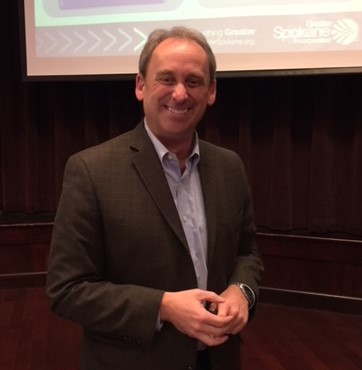North Notes
Spokane North Rotary Club Bulletin
November 13, 2017
Briefly:
Welcome back: It was good to see two former club members at the Nov. 13 luncheon. Sherill Pederson, who joined Spokane North in 2007 and was in the “blood banking” classification, now is president of the Aurora Northwest club. Todd Mielke, the day’s speaker, joined in 2006 as “government affairs consulting.” He now is CEO of Greater Spokane, Inc.
Holiday time: President Chad Haverkamp said the annual club Christmas luncheon will be Monday, Dec. 11 at The Lincoln Center.
Prayers and hugs: Some members have met with Melody Farance, long-time member and director, who is in hospice care in South Spokane. Jodi Harland said Melody would welcome an occasional home-cooked meal. Contact Jodi or Lenore Romney.
In passing: A recent obituary noted the death Oct. 21 of former member and director Ronald A. Gies, who had joined the club in 1976. Ron, who was 78, died of prostate cancer. He operated the Paramount Photo shop on north Monroe for many years. His classification was “cameras-retail.” Ron and wife, Evie, were married for 54 years.
Is Spokane ready for a port district?
What is the best way to develop area economic development? Is a port district a major strategy for growth?
 At the Nov. 13 luncheon, Todd Mielke, CEO of Greater Spokane, Inc., updated the issues and discussion. A few years back, former Journal of Business publisher Greg Bever, delivered a similar message to our club.
At the Nov. 13 luncheon, Todd Mielke, CEO of Greater Spokane, Inc., updated the issues and discussion. A few years back, former Journal of Business publisher Greg Bever, delivered a similar message to our club. Mielke noted there are 75 port districts in 33 of Washington State’s 39 counties. And no, port districts do not need to be near navigable waterways. Indeed, the current president of the state port district association is from Ephrata. Mielke adds that “Grant County is kicking our tush” in capturing jobs competing with Spokane by using its port district.
Established in 1911 by the legislature, port districts are municipal corporations which can develop land and provide economic development tools. The districts can assist development with airports, marinas, rail lines, roads, industrial parks and even tourism. Port districts have their own leaders, typically with 3 to 5 commissioners.
While economic development is always a topic is business and civic discussions, Amazon’s recent case study has added fuel. The Seattle-based soaring retailer says it wants to add a second campus with 50,000 new employees. The challenge has scrambled to find suitable sites all over North America, prompting hundreds of inquiries.
While metro Spokane doesn’t seem to be suitable – seeking areas of 1 million people or more – the “Amazonian” craze has renewed economic development strategies everywhere.
Mielke touted Spokane-area developments already in place, or pending, or hoping.
Fairchild has now been targeted to be the largest tanker base in the West, and in the next 3 years it might be the largest tanker fleet in the country, with 60 aircraft, which could grow employment at the base to as many as 14,000, he said.
The growing medical community has mushroomed, with plans to house 120 medical students at Spokane’s two campuses, up from just 20 students 4 years ago, Mielke said. He added that Seattle’s medical space is capped at 100.
As examples, he said, a port district in Spokane County could facilitate UP and BNSF rail transit near Cheney and the North Spokane Corridor developments near the former Kaiser-Mead and R.A. Hanson properties. It could also expand aircraft painting facilities near the airport.
Port districts have some funding sources, including sales tax and a “public safety sales tax.” Districts are enacted by 50 per cent majorities in the area organized.
Mielke showed a three-phase program for port districts. Phase One, the “due diligence” stage, is completed. Phase Two – feasibility – is under way now. Phase Three would be a campaign. That possibility might include matching funds of cities, states and federal sources.
Mielke noted the 10th anniversary this year when the former Spokane Area Economic Development Council was merged into the Spokane Area Chamber of Commerce to create the GSI.
One critic of GSI’s initiative is entrepreneur Tom Simpson, who talked at the club this spring.
Simpson argues that economic development should be “un-merged” with GSI. In his monthly Inlander column Nov. 2, he cited “conflicts.” He said established firms are wary about competing development and claims that high tech firms have not been given high priority at GSI. He also argues that a regional partnership – including Coeur d’Alene, Sandpoint and Pullman-Moscow – should be a better way than a county-wide Spokane Port District. However, some leaders in North Idaho cities over the years have been reluctant to merge cross-state development ideas.
Also, the City of Spokane recently hired a business development manager for recruitment and Spokane County itself has discussed about development possibilities.
Mielke stresses the economies of joining forces of the Chamber and the EDC. Many business leaders “are exactly the same people who need to be here (at both).
There were too many events if you have to go to two organizations,” he said.
So the discussion continues. Will Spokane add a 76th port district? Will a hybrid version of development emerge? Or will voters oppose another government district?
The bulletin producers:
Bulletin editors: Chuck Rehberg and Sandy Fink
Photos: Sandy Fink and Eric Johnson
Program coordinator: Brad Stark
